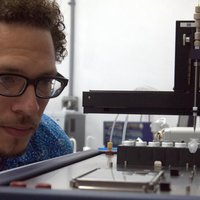"1,200 million people live in areas where water is a scarce resource, according to a 2007 UN report. The most affected areas are also some of the poorest. One fifth of the world's population sees its development strangled by droughts, and global warming will only worsen the situation.
David Cohen-Tanugi, a doctoral student in the Department of Engineering and Materials Science at the Massachusetts Institute of Technology - MIT (USA), was well aware of this when he started to contemplate how nanotechnology could help improve water quality in the 21st century. Five years later he has an answer: a nanoporous graphene membrane capable of desalinating water more efficiently and with much lower power consumption than the current methods based on polymers.
Graphene is a laminar conformation of carbon, a single atom thick. Through special treatments, controlled sized pores can be generated in this uniform layer so that the sheet becomes permeable to particles smaller than a certain size, preventing the passage of bigger ones. Cohen-Tanugi computationally showed in 2012 that the nanoporous graphene thus created could let water molecules pass but filter the salt ions in it.
Graphene membranes are 1.000 times thinner than the polyamide filters used to desalinate water. Yet, it withstands the high pressures required for the reverse osmosis process used in desalination plants.
While studying for his Bachelor degree in Physics at Princeton University (USA), Cohen-Tanugi spent one summer working with an environmental organization with a cooperation program for sustainable energy development projects in China. After completing his studies, he worked for them in Washington (USA) for a year. From these experiences he was motivated to go to MIT intending to ""make a contribution to clean energy based on new technologies.""
Energy consumption accounts for about 40% of the economic cost of the desalination process. According to the calculations of this young researcher, nanoporous graphene membranes will reduce the electric bill of desalination plants by 15% for those using seawater, and up to 45% for those that use brackish water.
""It is never possible to know exactly how soon a new technology can be implemented, but I am frankly amazed at how fast this field is progressing,"" says Cohen-Tanugi. In March of this year, an independent laboratory produced a sheet of these features and proved its permeability. ""We now need to produce it on a large scale,"" says the researcher.
Florence Lambert, Director, Laboratory for Innovation in New Energy Technologies and Nanomaterials, French Alternative Energies and Atomic Energy Commission and judge of the MIT Technology Review Innovators under 35 France awards, highlights both the high innovation of the nanomaterial devised by Cohen-Tanugi and the importance of the problem that the innovator is trying to solve.
However, further development of this technology lies outside of his expertise. So, while the scientific community continues to make nanoporous graphene a reality, he will go in another direction: aiming at reducing the energy spent by adjusting room temperature to the occupants’ preferences. For this purpose, his start-up has developed Wristify, a device in the form of a bracelet that transmits its wearer a feeling of warmth or coolness, improving comfort without having to modify the room’s temperature."




